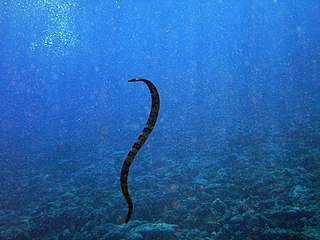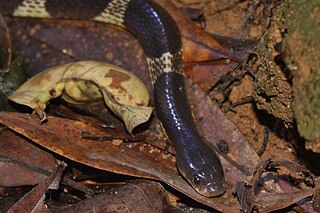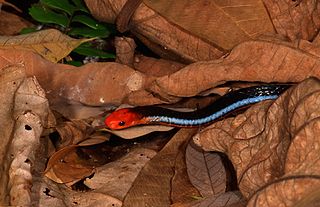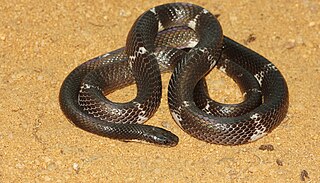
Elapidae is a family of snakes characterized by their permanently erect fangs at the front of the mouth. Most elapids are venomous, with the exception of the genus Emydocephalus. Many members of this family exhibit a threat display of rearing upwards while spreading out a neck flap. Elapids are endemic to tropical and subtropical regions around the world, with terrestrial forms in Asia, Australia, Africa, and the Americas and marine forms in the Pacific and Indian Oceans. Members of the family have a wide range of sizes, from the 18 cm (7.1 in) white-lipped snake to the 5.85 m king cobra. Most species have neurotoxic venom that is channeled by their hollow fangs, and some may contain other toxic components in various proportions. The family includes 55 genera with around 360 species and over 170 subspecies.

Bungarus is a genus of elapids native to Asia. Often found on the floor of tropical forests in South Asia, Southeast Asia and Southern China, they are medium-sized, highly venomous snakes with a length typically not exceeding 2 metres. These are nocturnal ophiophagious predators which prey primarily on other snakes at night, occasionally taking lizards, amphibians and rodents. Most species are with banded patterns acting as a warning sign to their predators. Despite being considered as generally docile and timid, kraits are capable of delivering highly potent neurotoxic venom which is medically significant with potential lethality to humans. The genus currently holds 16 species and 5 subspecies.

Sinomicrurus macclellandi, commonly known as MacClelland's coral snake, is a species of venomous snake in the family Elapidae. The species is endemic to southern and eastern Asia.

The yellow-lipped sea krait, also known as the banded sea krait or colubrine sea krait, is a species of venomous sea snake found in tropical Indo-Pacific oceanic waters. The snake has distinctive black stripes and a yellow snout, with a paddle-like tail for use in swimming.

The blue-lipped sea krait, also known as the blue-banded sea krait or common sea krait, is a species of venomous sea snake in the subfamily Laticaudinae of the family Elapidae. It is found in the Indian and Western Pacific Oceans.

Sea snakes, or coral reef snakes, are elapid snakes that inhabit marine environments for most or all of their lives. They belong to two subfamilies, Hydrophiinae and Laticaudinae. Hydrophiinae also includes Australasian terrestrial snakes, whereas Laticaudinae only includes the sea kraits (Laticauda), of which three species are found exclusively in freshwater. If these three freshwater species are excluded, there are 69 species of sea snakes divided between seven genera.

Sea kraits are a genus of venomous elapid sea snakes, Laticauda. They are semiaquatic, and retain the wide ventral scales typical of terrestrial snakes for moving on land, but also have paddle-shaped tails for swimming. Unlike fully aquatic ovoviviparous sea snakes, sea kraits are oviparous and must come to land to digest prey and lay eggs. They also have independent evolutionary origins into aquatic habitats, with sea kraits diverging earlier from other Australasian elapids. Thus, sea kraits and sea snakes are an example of convergent evolution into aquatic habitats within the Hydrophiinae snakes. Sea kraits are also often confused with land kraits , which are not aquatic.

The katuali or flat-tail sea snake is a species of venomous sea snake in the family Elapidae. The species is found only in the waters of the Pacific Islands nation of Niue.

The many-banded krait, also known as the Taiwanese krait or the Chinese krait, is a highly venomous species of elapid snake found in much of central and southern China and Southeast Asia. The species was first described by the scientist Edward Blyth in 1861. Averaging 1 to 1.5 m in length, it is a black or bluish-black snake with many white bands across its body. The many-banded krait mostly inhabits marshy areas throughout its geographical distribution, though it does occur in other habitat types.
The wildlife of Japan includes its flora, fauna, and natural habitats. The islands of Japan stretch a long distance from north to south and cover a wide range of climatic zones. This results in a high diversity of wildlife despite Japan's isolation from the mainland of Asia. In the north of the country, north of Blakiston's Line, there are many subarctic species which have colonized Japan from the north. In the south there are south-east Asian species, typical of tropical regions. Between these areas lies the temperate zone which shares many species with China and Korea. Japan also has many endemic species that are found nowhere else in the world, making it home to many endangered/rare species.

Calliophis bivirgatus is a species of snake in the family Elapidae known commonly as the blue coral snake or blue Malayan coral snake. It is native to Southeast Asia.

Bungarus ceylonicus, the Ceylon krait or Sri Lankan krait, is a species of venomous elapid snake which is endemic to the island Sri Lanka, locally known as මුදු කරවලා.

Coral reef fish are fish which live amongst or in close relation to coral reefs. Coral reefs form complex ecosystems with tremendous biodiversity. Among the myriad inhabitants, the fish stand out as colourful and interesting to watch. Hundreds of species can exist in a small area of a healthy reef, many of them hidden or well camouflaged. Reef fish have developed many ingenious specialisations adapted to survival on the reefs.
Latisemin is a cysteine-rich secretory protein that can be isolated from the venom of the Black-banded sea krait, a sea snake indigenous to the warmer waters of the western Pacific Ocean. It is a toxin that inhibits cyclic nucleotide-gated ion channels and blocks L-type calcium channels, thereby reducing smooth muscle contraction.

The New Caledonian sea krait is a species of venomous snake in the subfamily Laticaudinae of the family Elapidae. The species is native to the waters around New Caledonia.
Laticauda guineai is a species of venomous sea snake in the family Elapidae. The species, which was first described by Heatwole, Busack and Cogger in 2005, is native to waters off southern New Guinea.














